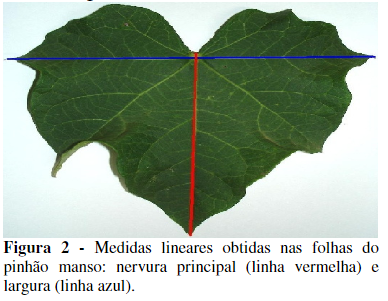Sampling forms and times in Jatropha leaves for leaf area quantification
DOI:
https://doi.org/10.20873/jbb.uft.cemaf.v2n3.martinssantosKeywords:
Jatropa curcas L., leaf area, non-destructive methodologyAbstract
This work aimed to determine the ideal leaf size, and also in which position of the plant such measurements must be processed in Jatropha curcas. The experiment was carried out at the Federal University of Tocantins in a randomized complete block design with 24 treatments and 6 replicates. A method based on leaf length and leaf width was used to determine total leaf area. The results showed that total leaf area was underestimated when only small leaves were sampled. On the other hand, total leaf area was overestimated when only large leaves were sampled. It shows that the measurement of large and medium leaves at the upper and middle of the plant can be used to determine total leaf area. We therefore conclude that sampling forms is determined by the period of measurement; the fourth period of measurement is the most indicated to quantify the width of Jatropha curcas leaves; and to the measurement of total leaf area, the upper side of the plant was the best place of sampling.
References
Avelar, R. C.; Castro, R. P.; Araujo, J. C.; Dourado, D. C.; Junco, B. B.; Marconato, F. E.; Fraga, A. C.; Castro Neto, P. Emergência e mortalidade de brotações de manivas de pinhão manso (Jatropha curcas L.) In: CONGRESSO BRASILEIRO DE PLANTAS OLEAGINOSAS, ÓLEOS, GORDURAS E BIODIESEL. Universidade Federal de Lavras, 3, 2006.
Benincasa, M. M. P. (1988), Análise de crescimento de plantas: noções básicas. Jaboticabal: FUNEP, 42p.
Favarin, J. L.; Dourado Neto, D.; García, A. G.; Villa Nova, N. A.; Favarin, M. G. G. V. (2002), Equações para a estimativa do índice de área foliar do cafeeiro. Pesquisa Agropecuária Brasileira, 37, 769-773.
Heller, J. Physic nut. Jatropha curcas L. PhD Thesis - Institute of Plant Genetic and Crop Plant
Research, Gatersleben, Germany, and International Plant Genetic Resource Institute, 1996.
Monteiro, J. E. B. A.; Sentelhas, P. C.; Chiavegato, E. J.; Guiselini, C.; Santiago, A. V.; Prela, A. (2005), Estimação da área foliar do algodoeiro por meio de dimensões e massa das folhas. Bragantia, 64, 15-24.
Nunes, C. F.; Pasqual, M.; Favero, A. C.; Oliveira, D. L. Efeito da sacarose no cultivo in vitro de embriões zigóticos de pinhão-manso. In: CONGRESSO BRASILEIRO DE PLANTAS OLEAGINOSAS, ÓLEOS, GORDURAS E BIODIESEL. Universidade Federal de Lavras, 3, 2006.
Oliveira, M. N. S.; Lopes, P. S. N.; Mercadante, M. O.; Oliveira, G. L.; Gusmão, E. (2002), Medição da área foliar do pequizeiro utilizando a soma da nervura principal dos folíolos. Unimontes Científica, 3, 1-7.
Saturnino, H. M.; Pacheco, D. D.; Kakida, J.; Tominaga, N.; Gonçalves, N. P. (2005), Cultura do pinhão manso. Informe Agropecuário, 26, 44-78.
Severino, L. S.; Cardoso, G. D.; Vale, L. S.; Santos, J. W. (2004), Método para determinação da área foliar da mamoneira. Revista Brasileira de Oleaginosas e Fibrosas, 8, 753-762.
Severino, L. S.; Vale, L. S.; Beltrão, N. E. M. (2007), A simple method for measurement of Jatropha curcas leaf área. Revista brasileira de oleaginosas e fibrosas, 11, 9-14.

Published
How to Cite
Issue
Section
License
Copyright (c) 2024 - Journal of Biotechnology and Biodiversity

This work is licensed under a Creative Commons Attribution 4.0 International License.
Authors who publish with this journal agree to the following terms:
Authors retain copyright and grant the journal right of first publication with the work simultaneously licensed under a Creative Commons Attribution License (CC BY 4.0 at http://creativecommons.org/licenses/by/4.0/) that allows others to share the work with an acknowledgement of the work's authorship and initial publication in this journal.
Authors are able to enter into separate, additional contractual arrangements for the non-exclusive distribution of the journal's published version of the work (e.g., post it to an institutional repository or publish it in a book), with an acknowledgement of its initial publication in this journal.
Authors are permitted and encouraged to post their work online (e.g. in institutional repositories or on their website) prior to and during the submission process, as it can lead to productive exchanges, as well as earlier and greater citation of published work (Available at The Effect of Open Access, at http://opcit.eprints.org/oacitation-biblio.html).


